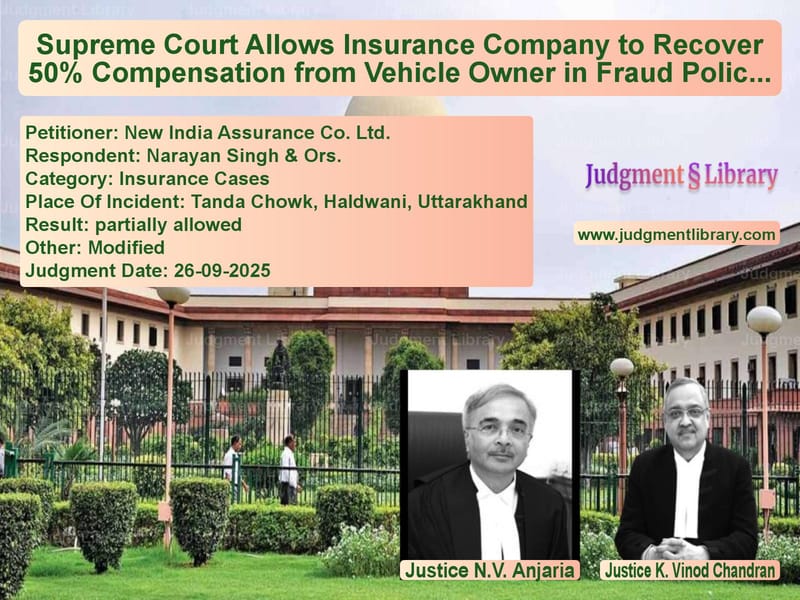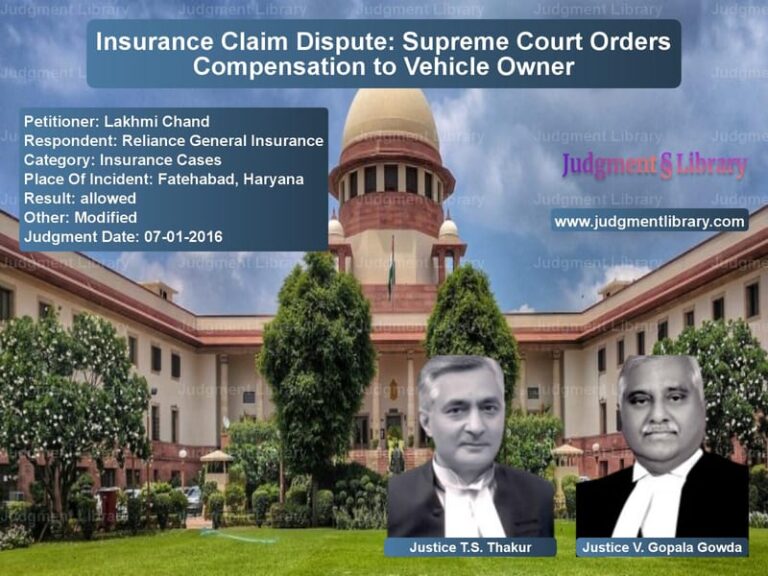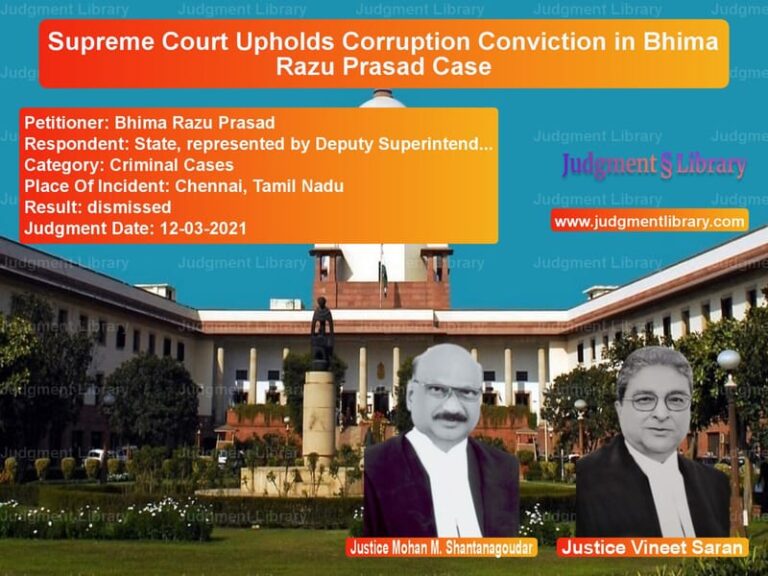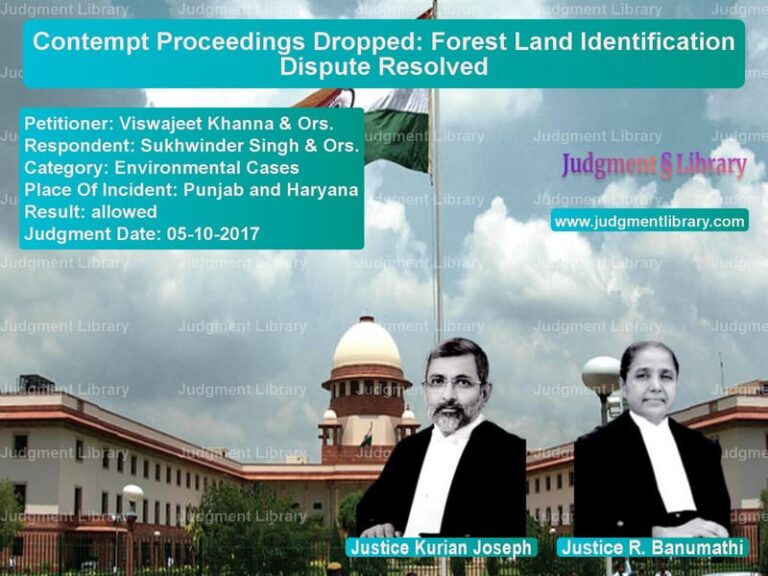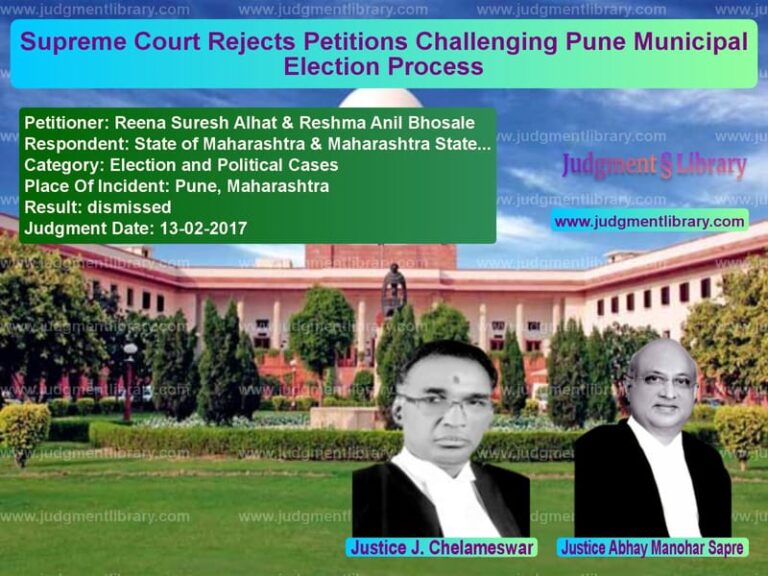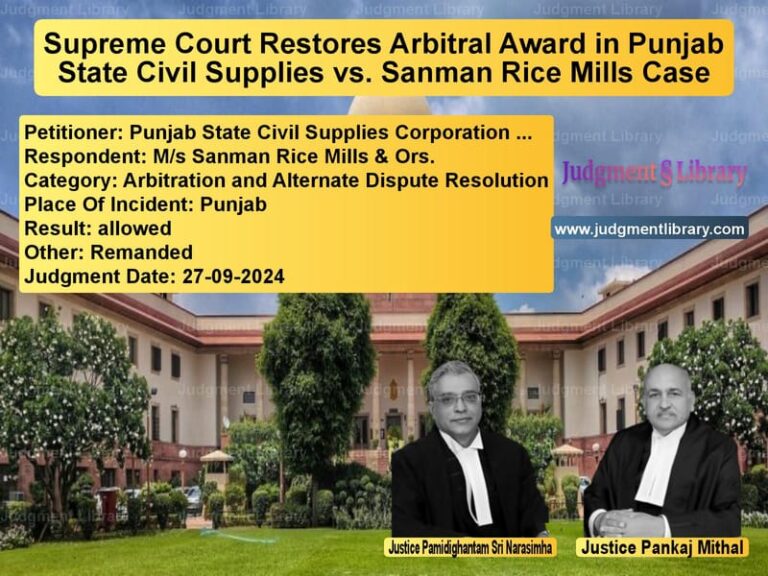Supreme Court Allows Insurance Company to Recover 50% Compensation from Vehicle Owner in Fraud Policy Case
In a significant ruling that balances the interests of accident victims and insurance companies, the Supreme Court has modified a compensation award to allow an insurance company to recover half the amount from the vehicle owner after discovering fraudulent manipulation of insurance policy dates. The case involved a tragic road accident that claimed the life of a 21-year-old security guard and subsequent legal battles over compensation liability.
The Tragic Accident and Initial Proceedings
The case originated from a devastating road accident that occurred on June 21, 2006, near Tanda Chowk. Hem Singh Mehta, a 21-year-old security guard earning Rs. 4,000 per month, was waiting for a bus when a truck bearing registration number UP-02-2354 hit him due to rash and negligent driving. The young victim succumbed to his injuries while undergoing treatment, leaving his family to seek compensation for their irreparable loss.
The legal journey began when the claimants approached the Motor Accident Compensation Tribunal in Haldwani, Nainital. The tribunal, after examining the evidence, recorded clear findings that the deceased died due to the rash and negligent driving of the truck driver. The tribunal then proceeded to assess compensation under various heads, ultimately awarding Rs. 3,87,000 to the bereaved family with 7% interest from the date of filing the application until payment. This compensation was declared recoverable from the insurance company.
The Insurance Policy Controversy
The case took an unusual turn when the insurance company discovered discrepancies in the insurance policy documentation. During the original claim proceedings, the vehicle owner had produced an insurance policy that appeared valid from June 17, 2006, to June 16, 2007. Since the accident occurred on June 21, 2006, the tribunal naturally concluded that insurance coverage was available on the date of the incident.
However, after the tribunal’s judgment, the New India Assurance Company Ltd. filed a review application raising a crucial ground that would fundamentally change the case. The insurance company revealed that when the insurance policy bearing No. 353800/31/06/02/00002785 was sent for verification to the issuing office at Rohtak, the competent office informed that the actual validity period was from June 28, 2006, to June 27, 2007. This meant that on the date of the accident—June 21, 2006—the insurance policy was not actually in operation. The insurance company alleged that the vehicle owner had fraudulently changed the validity dates to create the impression that coverage existed on the accident date.
The tribunal, however, dismissed the review application through its order dated October 12, 2007, stating that it had no power under the Act to review its own judgment. This procedural limitation would become a significant factor in the subsequent legal proceedings.
Appeals to the Higher Courts
Unsatisfied with the tribunal’s decision, the insurance company preferred an appeal before the High Court of Uttarakhand. The company’s main contention remained that “the judgment and decree of the Claims Tribunal was based on misrepresentation as the dates of the validity period of the insurance policy was wrongly projected and it was a fraudulent act on the part of the owner to change the dates.”
Meanwhile, the claimants also filed a cross-appeal seeking enhancement of the compensation amount. The High Court, after examining the case, upheld the tribunal’s assessment of compensation. The court noted that “the income of the deceased was rightly taken by the Tribunal at Rs. 36,000/- per annum, that the dependency was assessed to be at Rs. 24,000/- and by taking multiplier of 15, the compensation was worked out which was just appropriate compensation.” The High Court also observed that the tribunal had awarded additional sums towards loss of estate and funeral expenses.
Significantly, the High Court noted that the insurance company had not challenged the tribunal’s order dated October 12, 2007, which dismissed the review application. Based on this and other considerations, the High Court dismissed both the insurance company’s appeal and the claimants’ cross-appeal. Only the insurance company pursued the matter further by approaching the Supreme Court.
The Supreme Court’s Deliberation
Before the Supreme Court, the insurance company reiterated its primary contention that “the insurance policy when verified was for the period of 28.06.2006 to 27.06.2007 and on the date of the accident there was no insurance coverage, and the policy was not in operation.”
The court carefully examined the sequence of events and the procedural history of the case. It noted that “this contention was raised by the Insurance Company only in the review petition. Nothing was produced in the main claim proceedings because of which the Tribunal proceeded on the basis that the insurance policy was valid on the date of the accident. Though the allegation of fraud is levelled but it could not be proved by the insurer.”
The court also emphasized a crucial procedural lapse: “Furthermore, the order dated 12.10.2007 passed in the review application was not challenged by the Insurance Company before the High Court for the reasons best known to it.”
The Balanced Judgment
While expressing its general disinclination to interfere with the High Court’s judgment, the Supreme Court recognized the unique circumstances of the case. The court stated: “This Court is not inclined to interfere with the judgment and order of the High Court. However, in the totality of the facts and circumstances when it was brought on record that upon a verification of the policy, its period did not cover the date when accident occurred, it would subserve the ends of justice if the appellant-Insurance Company is allowed to recover 50% of the compensation from the owner and the driver in accordance with law.”
This balanced approach acknowledged both the insurance company’s legitimate concern about the fraudulent manipulation of policy dates and the paramount need to ensure that the accident victims receive their compensation without unnecessary hardship.
The court further directed that “if any part of the compensation is not deposited by the appellant-insurance company, the same shall be deposited by it before the Tribunal concerned within six weeks from today.”
Legal Principles and Implications
This judgment highlights several important legal principles in motor accident compensation cases. First, it underscores the importance of authentic documentation in insurance claims. The case demonstrates how fraudulent manipulation of documents can create complex legal situations that require careful judicial resolution.
Second, the judgment emphasizes the procedural requirements in legal proceedings. The insurance company’s failure to challenge the tribunal’s review order before the High Court significantly influenced the Supreme Court’s approach to the case. This serves as a reminder to litigants about the importance of comprehensively addressing all relevant orders in appeals.
Third, the ruling reflects the courts’ efforts to balance competing interests—protecting insurance companies from fraudulent claims while ensuring that genuine accident victims receive compensation. The 50% recovery formula represents a middle path that acknowledges the insurance company’s legitimate concerns while prioritizing the victims’ right to compensation.
The judgment also illustrates the Supreme Court’s flexibility in crafting equitable solutions when faced with complex factual scenarios. Rather than applying a rigid legal formula, the court considered the totality of circumstances to reach a fair outcome.
Broader Impact on Insurance Litigation
This ruling has significant implications for the insurance industry and accident claim litigation. It sends a strong message about the consequences of document manipulation while also establishing that such manipulations cannot completely absolve insurance companies from their social responsibility towards accident victims.
For insurance companies, the judgment provides a legal basis to seek recovery from fraudulent parties while still fulfilling their immediate obligation to compensate victims. For vehicle owners, it serves as a warning about the serious consequences of manipulating insurance documents.
For accident victims and their families, the ruling reaffirms that their right to compensation remains protected even in cases involving documentation issues. The court’s primary concern remains ensuring that victims receive the compensation they need and deserve.
The Supreme Court’s modification of the impugned judgment, while technically dismissing the appeal, actually provided substantial relief to the insurance company by enabling recovery of half the compensation amount. This nuanced approach demonstrates the court’s ability to deliver substantive justice while maintaining procedural propriety.
As the Supreme Court concluded: “The impugned judgment and order is partially modified accordingly. The present appeal is dismissed subject to the above modification.” This concluding statement encapsulates the balanced nature of the judgment—dismissing the appeal in formal terms while substantially modifying the outcome to address the legitimate concerns raised by the insurance company.
Petitioner Name: New India Assurance Co. Ltd..Respondent Name: Narayan Singh & Ors..Judgment By: Justice N.V. Anjaria, Justice K. Vinod Chandran.Place Of Incident: Tanda Chowk, Haldwani, Uttarakhand.Judgment Date: 26-09-2025.Result: partially allowed.
Don’t miss out on the full details! Download the complete judgment in PDF format below and gain valuable insights instantly!
Download Judgment: new-india-assurance-vs-narayan-singh-&-ors.-supreme-court-of-india-judgment-dated-26-09-2025.pdf
Directly Download Judgment: Directly download this Judgment
See all petitions in Motor Insurance Settlements
See all petitions in Third-Party Insurance
See all petitions in Insurance Settlements
See all petitions in Other Insurance Cases
See all petitions in Compensation Disputes
See all petitions in Judgment by N.V. Anjaria
See all petitions in Judgment by K. Vinod Chandran
See all petitions in partially allowed
See all petitions in Modified
See all petitions in supreme court of India judgments September 2025
See all petitions in 2025 judgments
See all posts in Insurance Cases Category
See all allowed petitions in Insurance Cases Category
See all Dismissed petitions in Insurance Cases Category
See all partially allowed petitions in Insurance Cases Category

